Characteristic Mode Analysis of a Ka-Band CPW-Slot-Couple Fed Patch Antenna with Enhanced Bandwidth and Gain
Abstract
:1. Introduction
2. Antenna Design and Analysis
2.1. Antenna Configuration and Parametric Study
2.2. Characteristic Mode Analysis (CMA)
3. Simulation and Measured Results
3.1. Impedance Bandwidth and Radiation Gain
3.2. Radiation Patterns
3.3. Comparison and Discussion
4. Conclusions
Author Contributions
Funding
Institutional Review Board Statement
Informed Consent Statement
Conflicts of Interest
References
- Yin, J.; Wu, Q.; Yu, C. Broadband Symmetrical E-Shaped Patch Antenna with Multimode Resonance for 5G Millimeter-Wave Applications. IEEE Trans. Antennas Propag. 2021, 67, 4474–4483. [Google Scholar] [CrossRef]
- Khan, M.; Chowdhury, M. Analysis of Modal Excitation in Wideband Slot-Loaded Microstrip Patch Antenna Using Theory of Characteristic Modes. IEEE Trans. Antennas Propag. 2020, 68, 7618–7623. [Google Scholar] [CrossRef]
- Ma, C.; Ma, Z.H.; Zhang, X. Millimeter-Wave Circularly Polarized Array Antenna Using Substrate-Integrated Gap Waveguide Sequentially Rotating Phase Feed. IEEE Antennas Wirel. Propag. Lett. 2019, 18, 1124–1128. [Google Scholar] [CrossRef]
- Feng, B.; He, X.; Cheng, J.C. Dual-Wideband Dual-Polarized Metasurface Antenna Array for the 5G Millimeter Wave Communications Based on Characteristic Mode Theory. IEEE Access 2020, 8, 21589–21601. [Google Scholar] [CrossRef]
- Liu, P.; Zhu, X.W.; Zhang, Y. Patch Antenna Loaded with Paired Shorting Pins and H-shaped Slot for 28/38 GHz Dual-band MIMO Applications. IEEE Access 2020, 8, 23705–23712. [Google Scholar] [CrossRef]
- Zhang, X.; Tan, T.; Wu, Q.S. Pin-Loaded Patch Antenna Fed with a Dual-Mode SIW Resonator for Bandwidth Enhancement and Stable High Gain. IEEE Antennas Wirel. Propag. Lett. 2021, 20, 279–283. [Google Scholar] [CrossRef]
- Squadrito, P.; Zhang, S.; Pedersen, G.F. Wideband or Dual-Band Low-Profile Circular Patch Antenna with High-Gain and Sidelobe Suppression. IEEE Trans. Antennas Propag. 2018, 66, 3166–3171. [Google Scholar] [CrossRef]
- Liu, N.W.; Zhu, L.; Choi, W.W.; Zhang, J.D. A low-profile aperture-couple microstrip antenna with enhanced bandwidth under dual resonace. IEEE Trans. Antennas Propag. 2017, 65, 1055–1062. [Google Scholar] [CrossRef]
- Balanis, C.A. Antenna Theory: Analysis and Design; Wiley-Interscience: Hoboken, NJ, USA, 2005; pp. 15–64. [Google Scholar]
- Vogel, M.; Gampala, G.; Ludick, D.; Jakobus, U.; Reddy, C.J. Characteristic Mode Analysis: Putting Physics back into Simulation. IEEE Antennas Propag. Mag. 2015, 57, 307–317. [Google Scholar] [CrossRef]
- Kim, D.W.; Nam, S. Systematic Design of a Multiport MIMO Antenna with Bilateral Symmetry Based on Characteristic Mode Analysis. IEEE Trans. Antennas Propag. 2018, 66, 1076–1085. [Google Scholar] [CrossRef]
- Kim, G.; Kim, S. Design and Analysis of Dual Polarized Broadband Microstrip Patch Antenna for 5G mm Wave Antenna Module on FR4 Substrate. IEEE Access 2021, 9, 64306–64316. [Google Scholar] [CrossRef]
- Yang, X.; Liu, Y.; Gong, S. Design of a Wideband Omnidirectional Antenna with Characteristic Mode Analysis. IEEE Antennas Wirel. Propag. Lett. 2018, 17, 993–997. [Google Scholar] [CrossRef]
- Yang, H.Y.; Hua, B. A Low-Cost, Single-Layer, Dual Circularly Polarized Antenna for Millimeter-Wave Applications. IEEE Antennas Wirel. Propag. Lett. 2019, 18, 651–655. [Google Scholar] [CrossRef]
- Cao, D.; Li, Y.; Wang, J. A Millimeter-Wave Spoof Surface Plasmon Polaritons Fed Microstrip Patch Antenna Array. IEEE Trans. Antennas Propag. 2020, 68, 6811–6815. [Google Scholar] [CrossRef]
- Chen, H.; Shao, Y.; Zhang, Y. A Millimeter Wave Triple-band SIW Antenna with Dual-sense Circular Polarization. IEEE Trans. Antennas Propag. 2020, 68, 8162–8167. [Google Scholar] [CrossRef]
- Pan, Y.M.; Qin, X.; Sun, Y.X. A Simple Decoupling Method for 5G Millimeter-Wave MIMO Dielectric Resonator Antennas. IEEE Trans. Antennas Propag. 2019, 67, 2224–2234. [Google Scholar] [CrossRef]
- Nai-Chen, L.; Jenn-Hwan, T. Double-Curved Metal in Multilayer Printed Circuit Boards for Bandwidth Enhancemen of Millimeter-Wave Patch Antennas. IEEE Trans. Antennas Propag. 2021, 11, 1088–1906. [Google Scholar]
- Khan, Z.U.; Loh, T.H.; Belenguer, A. Empty Substrate Integrated Waveguide Fed Patch Antenna Array for 5G mm-Wave Communication Systems. IEEE Antennas Wirel. Propag. Lett. 2020, 19, 776–780. [Google Scholar] [CrossRef]
- Xue, M.; Wan, W.; Wang, Q. Low-Profile Millimeter-Wave Broadband Metasurface Antenna with Four Resonances. IEEE Antennas Wirel. Propag. Lett. 2021, 20, 463–467. [Google Scholar] [CrossRef]
- Jin, H.; Luo, G.Q.; Wang, W. Integration Design of Millimeter-Wave Filtering Patch Antenna Array with SIW Four-Way Anti-Phase Filtering Power Divider. IEEE Access 2019, 7, 49804–49812. [Google Scholar] [CrossRef]
- Xu, J.; Hong, W.; Jiang, Z.H. Low-Profile Wideband Vertically Folded Slotted Circular Patch Array for Ka-Band Applications. IEEE Trans. Antennas Propag. 2020, 68, 6844–6849. [Google Scholar] [CrossRef]
- Huayan, J.; Wenquan, C.; Kousheng, C. Millimeter-Wave TE20-Mode SIW Dual-Slot-Fed Patch Antenna Array with a Compact Differential Feeding Network. IEEE Trans. Antennas Propag. 2018, 66, 456–461. [Google Scholar]
- Yang, C.; Yuandan, D. Wideband Circularly Polarized Planar Antenna Array for 5G Millimeter-Wave Applications. IEEE Trans. Antennas Propag. 2021, 69, 2615–2627. [Google Scholar] [CrossRef]
- Klionovski, K.; Sharawi, M.S.; Shamim, A. A Dual-Polarization Switched Beam Patch Antenna Array for Millimeter-Wave Applications. IEEE Trans. Antennas Propag. 2019, 67, 3510–3515. [Google Scholar] [CrossRef]
- Yang, S.J.; Pan, Y.M.; Shi, L.Y. Millimeter-Wave Dual-Polarized Filtering Antenna for 5G Application. IEEE Trans. Antennas Propag. 2020, 68, 5114–5121. [Google Scholar] [CrossRef]
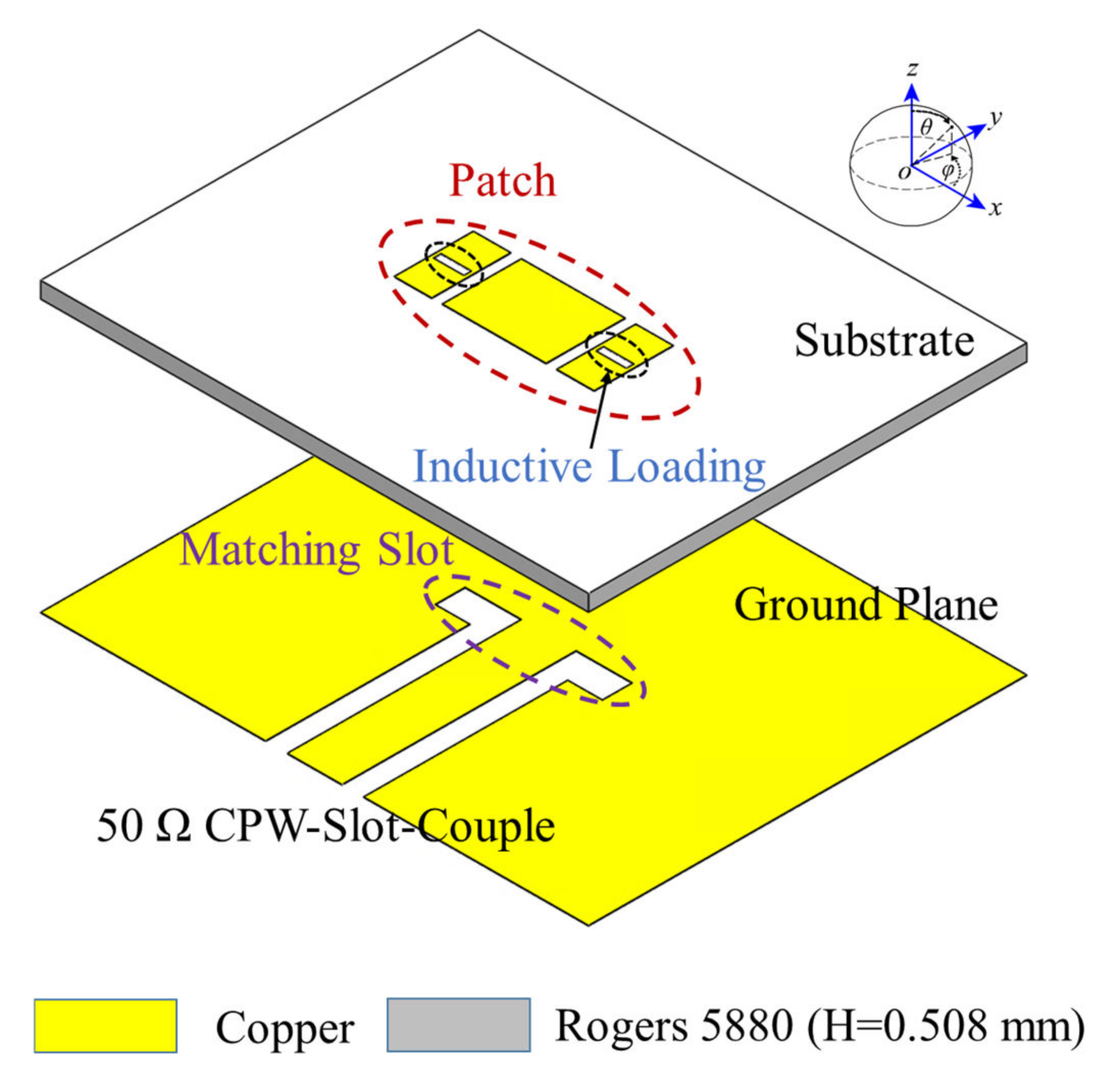
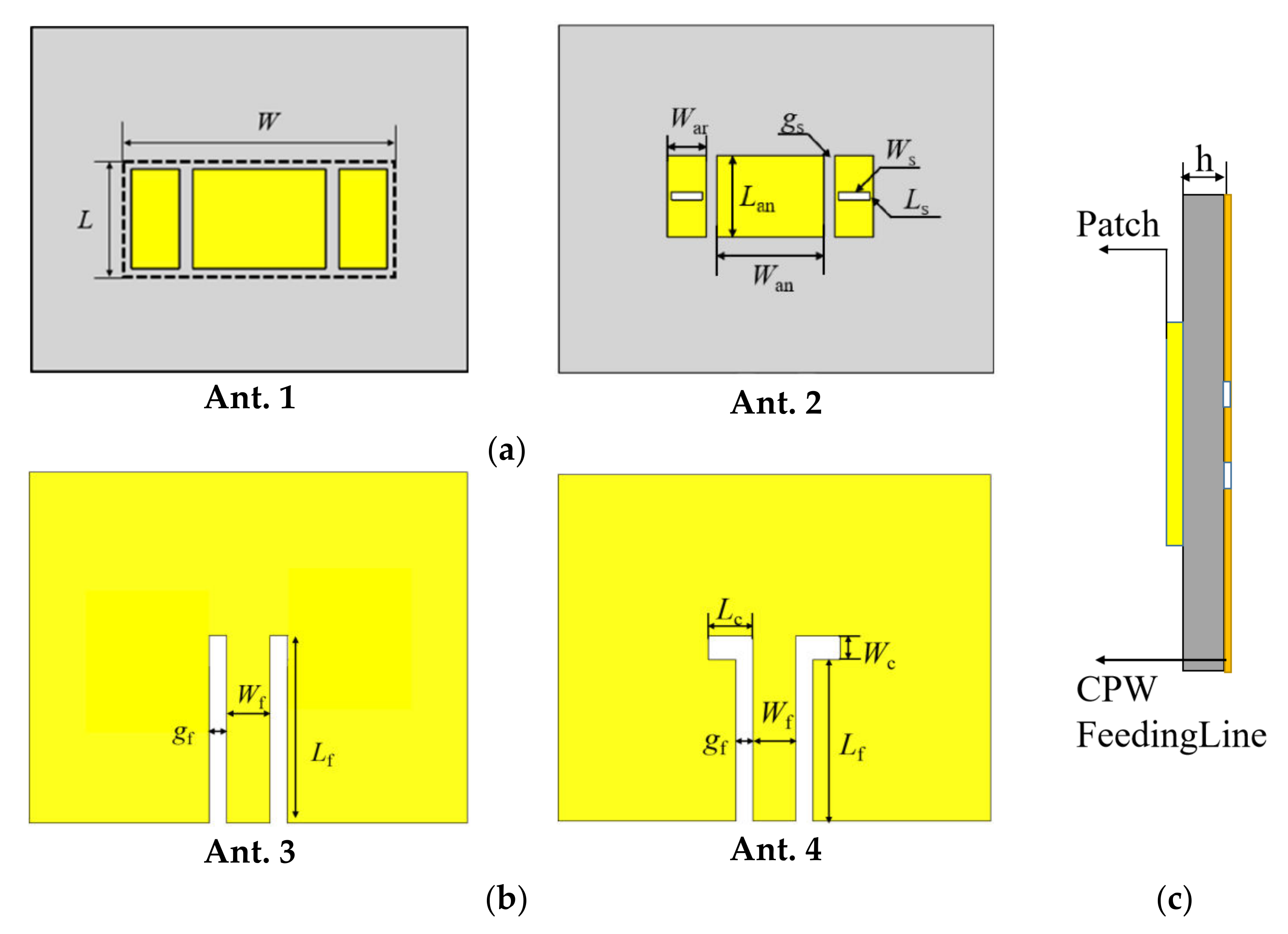
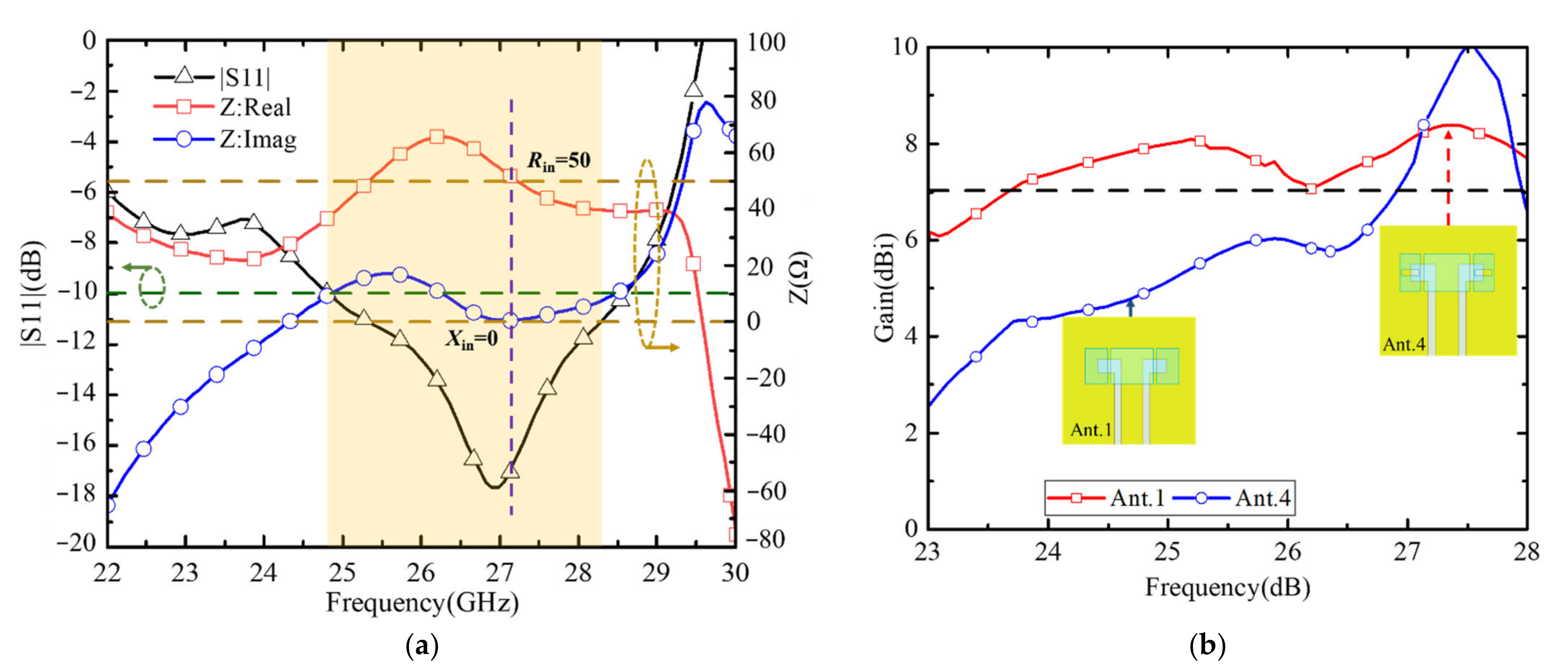
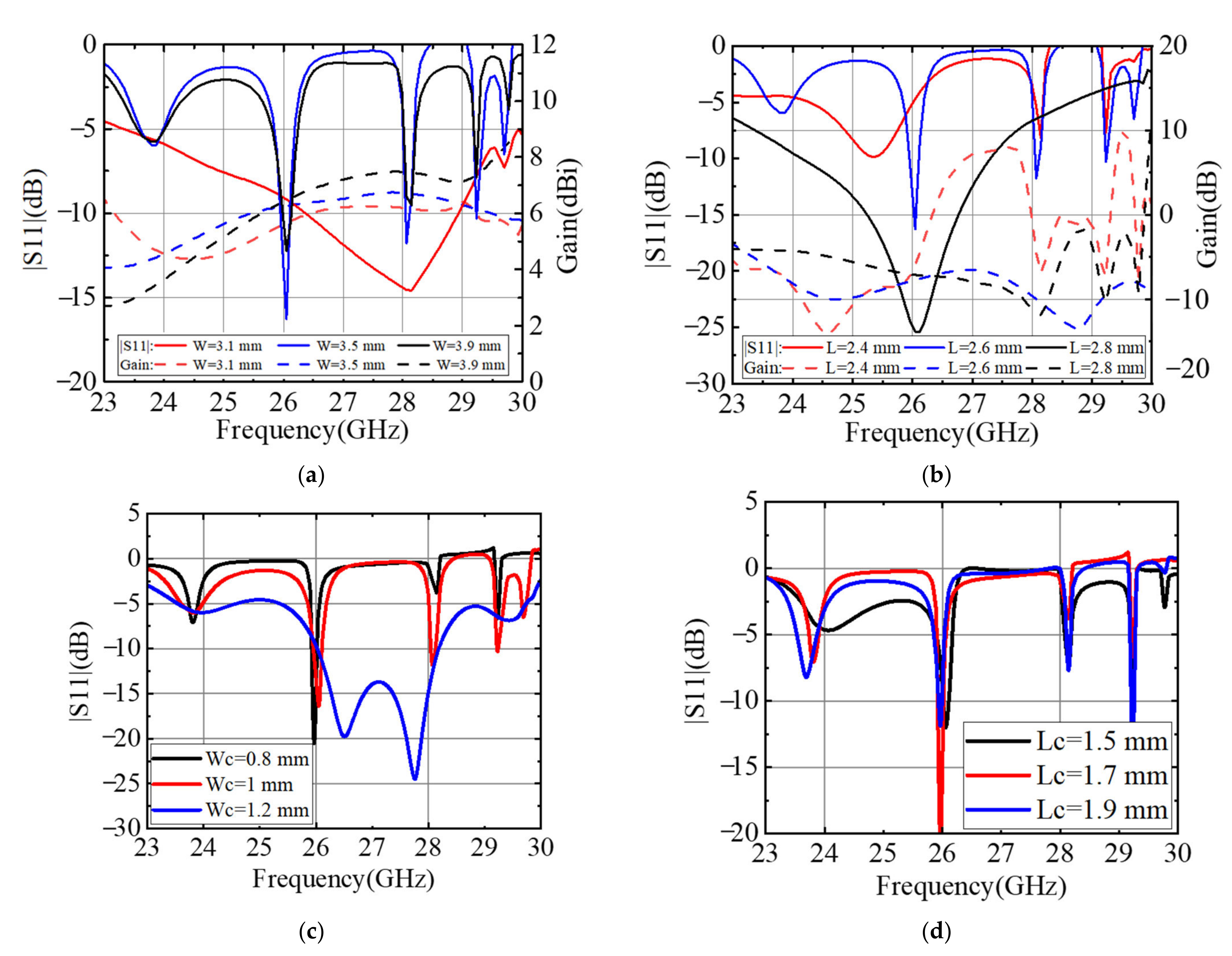

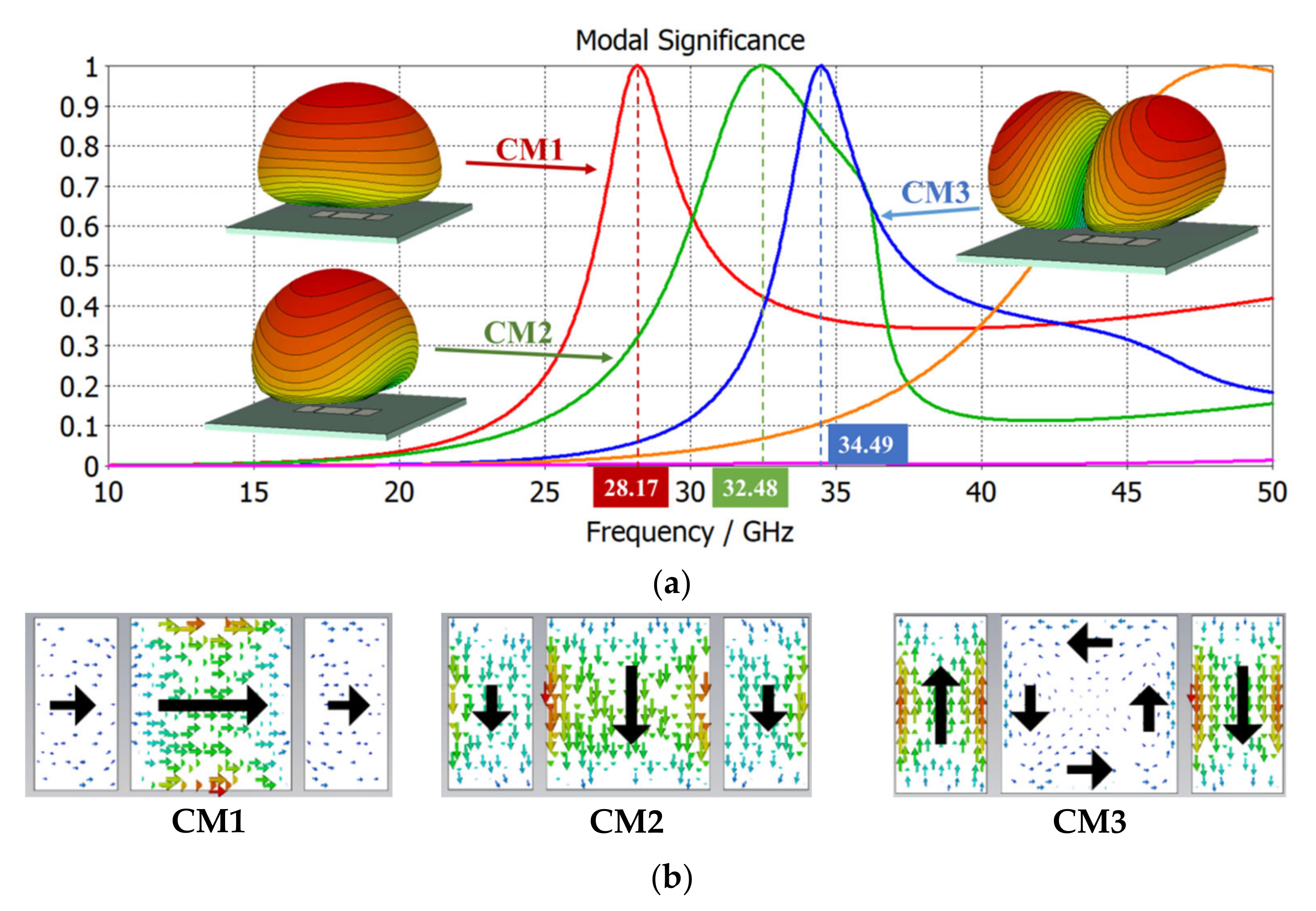
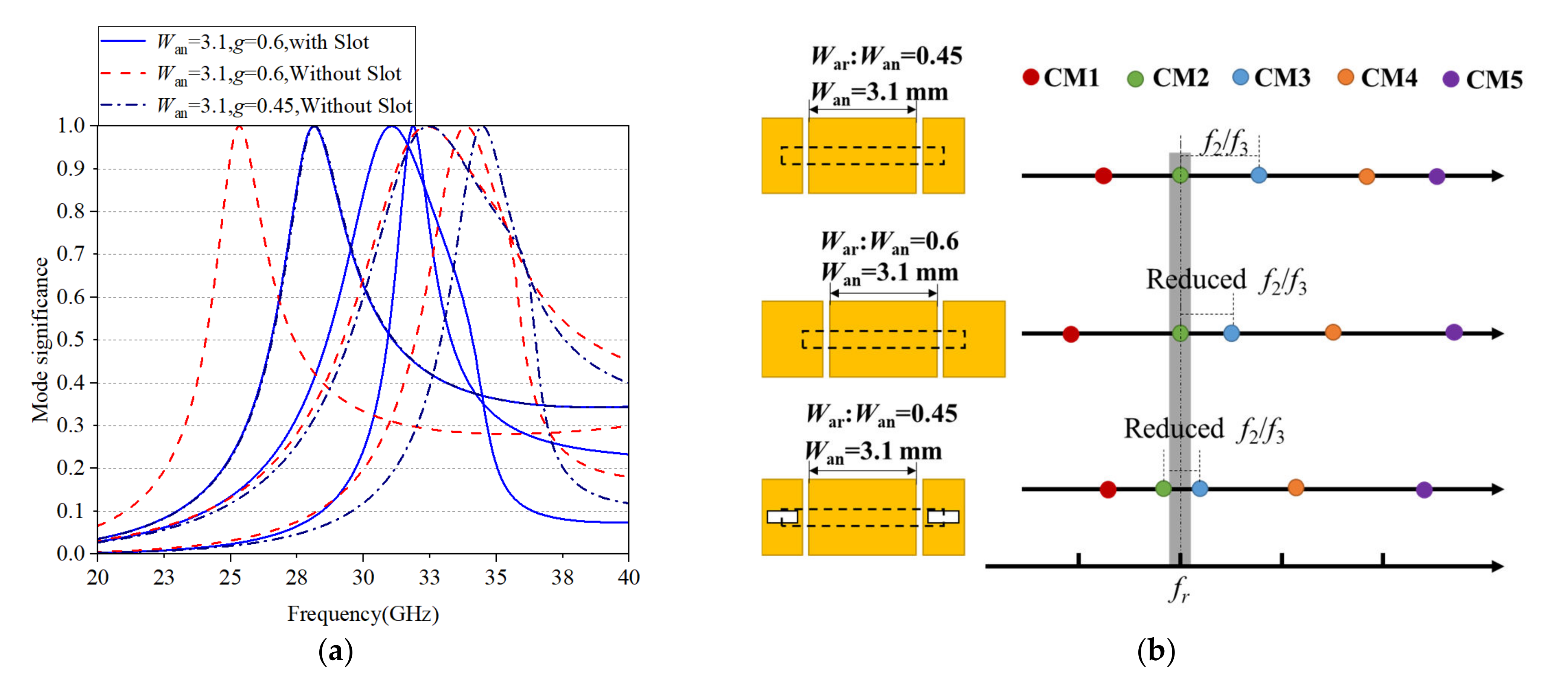


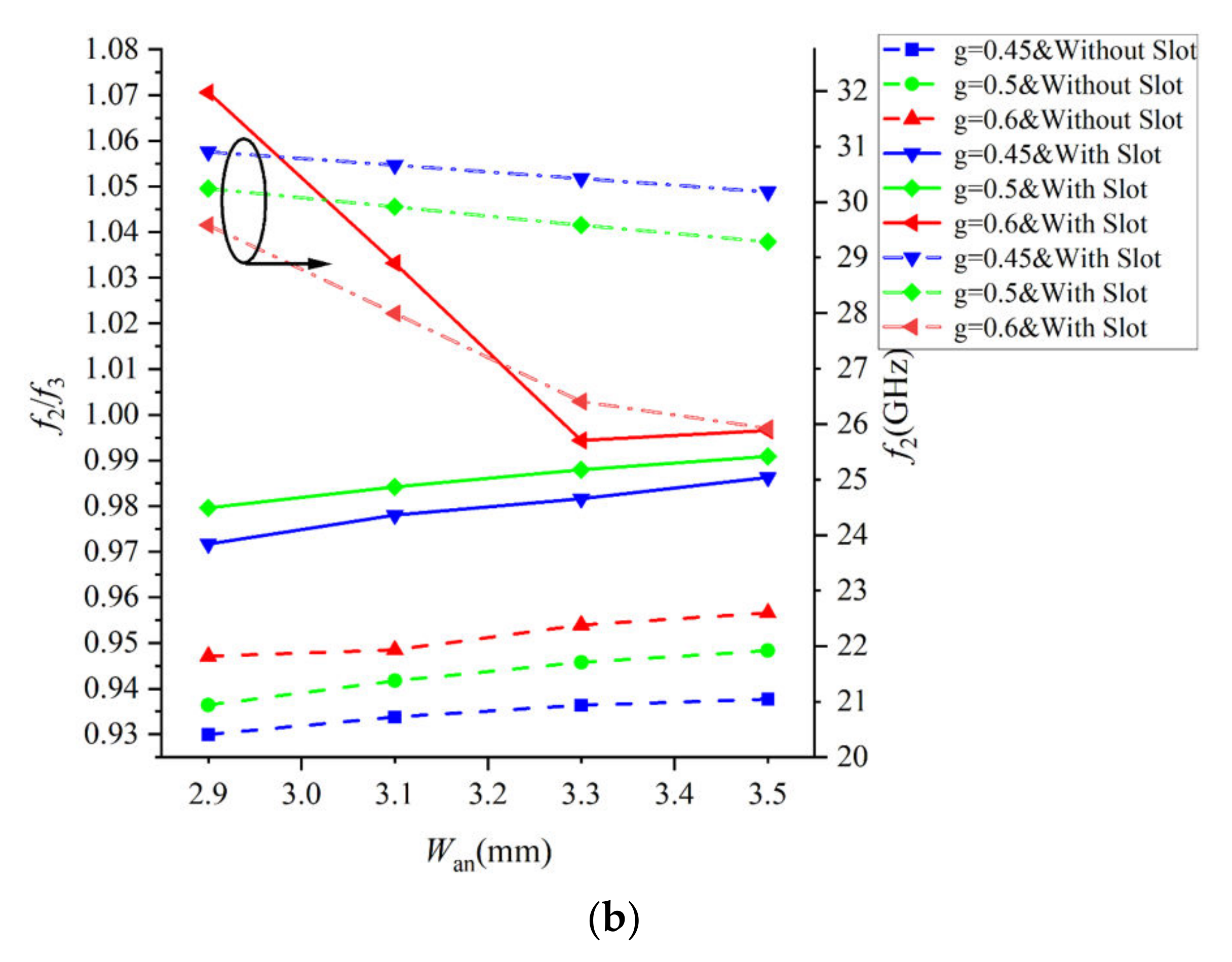

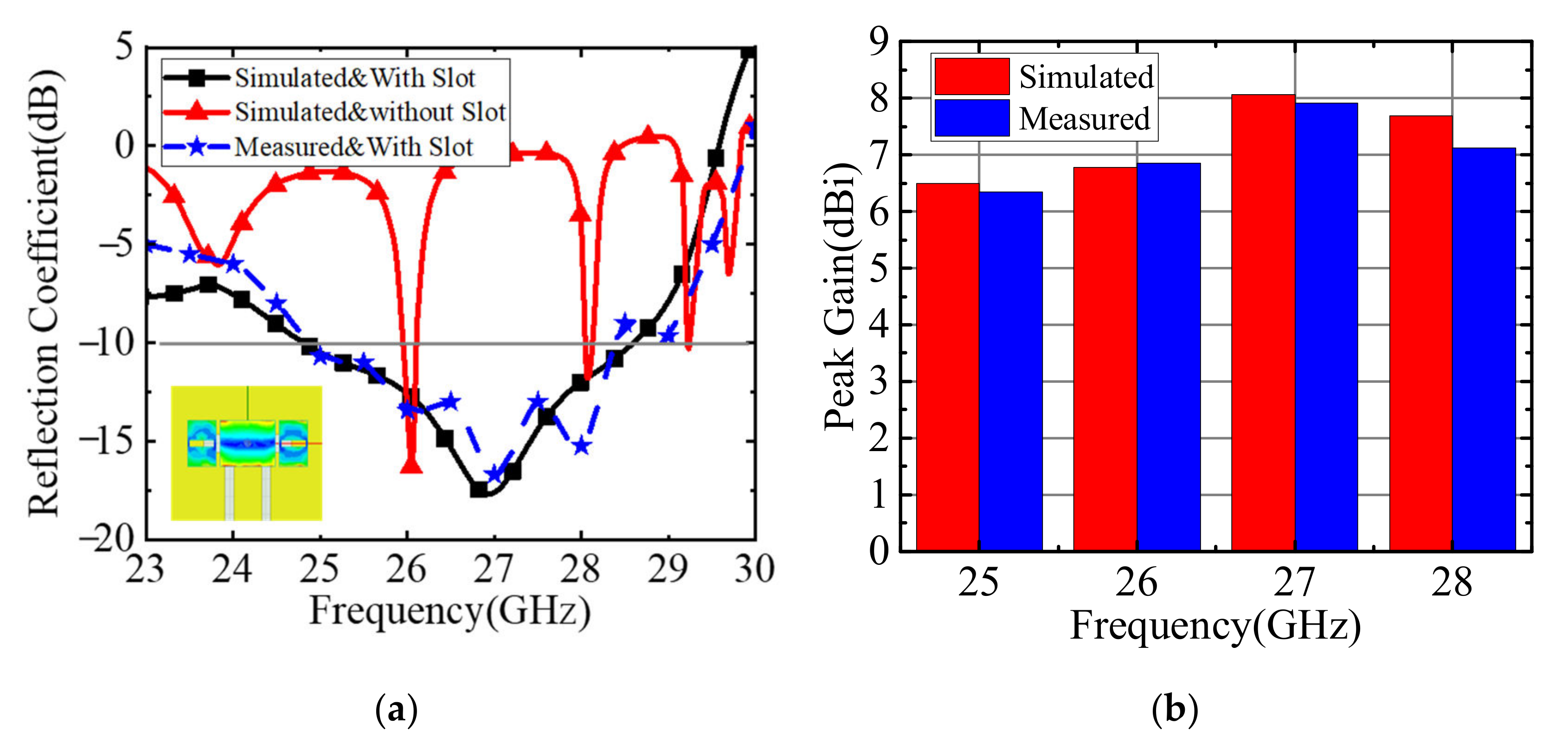
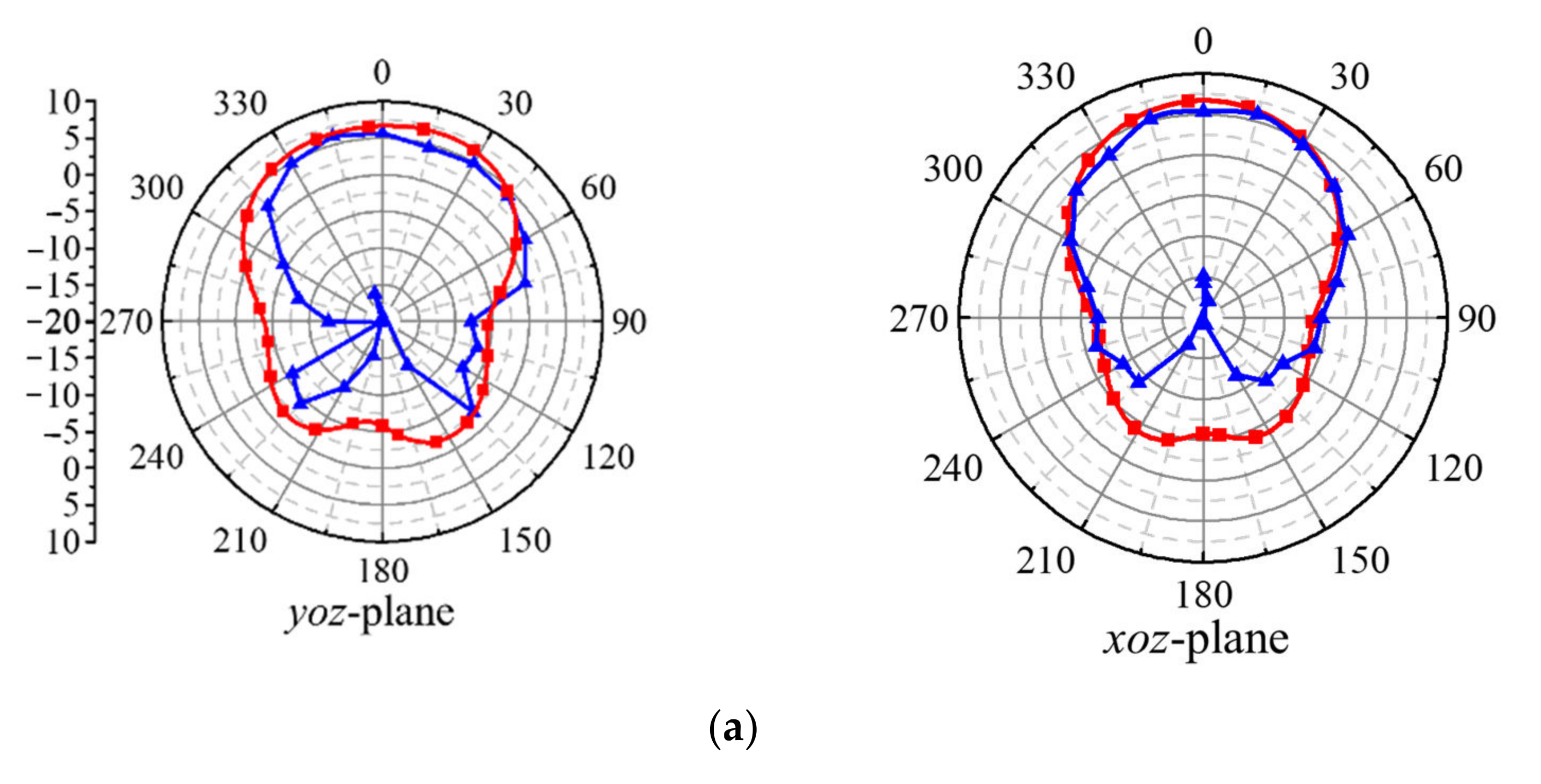
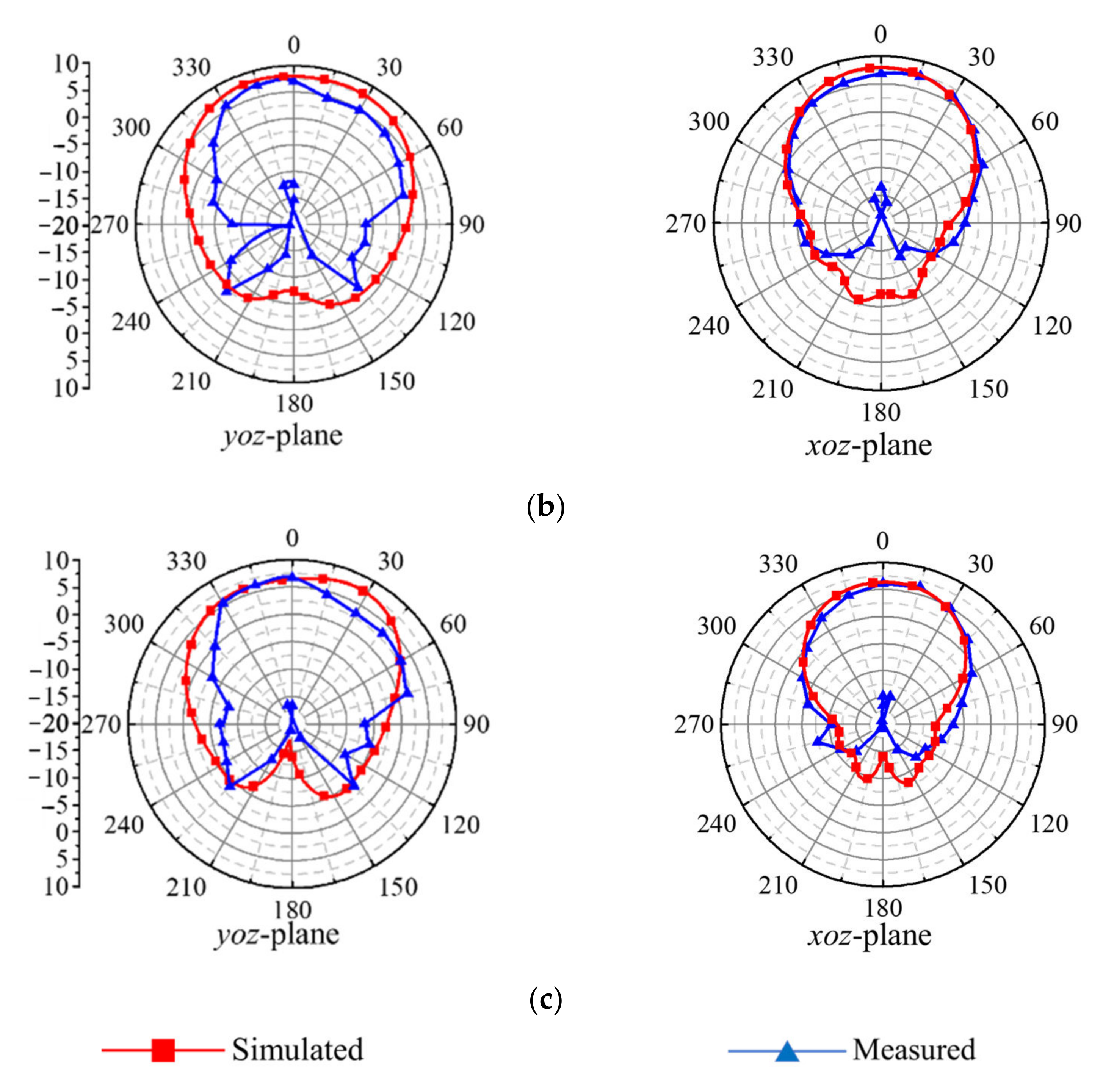
| Parameters | Value (mm) | Parameters | Value (mm) |
|---|---|---|---|
| Wan | 3.1 | Wc | 1 |
| War | 1.44 | Lc | 1.76 |
| Lan | 2.6 | Wf | 1.578 |
| Ws | 1.11 | Lf | 7.5 |
| gs | 0.25 | gf | 0.5 |
| Ls | 0.39 |
| Refs. | Printed Layers | Technique | f0 (GHz) | −10 dB|S11| BW (%) | Max. Gain (dBi) | Antenna Size (mm3) |
|---|---|---|---|---|---|---|
| [14] | 1 | shorting pin | 30 | 6.57% (29.13–31.10 GHz) | 11.8 | 3.5 × 2.8 × 0.508 |
| [15] | 1 | -- | 28 | 3.4% (27.5–28.5 GHz) | 2.3 | 3.6 × 3.6 × 0.508 |
| [16] | 1 | SIW & Shorting pin | 28 | 3.7% (27.46–28.5 GHz) | 6.9 | 30 × 15 × 0.3 |
| [17] | 1 | Shorting pin | 26 | 7.3% (25.1–27.0 GHz) | 6.3 | 4.5 × 4.5 × 1.5 |
| [18] | 2 | Air cavity-backed & coupled-feeding | 29 | 22.1% (27.4–34.2 GHz) | 8 | 15 × 15 × 0.67 |
| [19] | 2 | ESIW & Slot | 28.25 | 2.4% (26.5–30 GHz) | 12 | 2.6 × 4 × 1.016 |
| [20] | 2 | Shorting pin & Metasurface | 28 | 22% (24.4–30.5 GHz) | 6.5–10 | 10 × 10 × 0.23 |
| [21] | 2 | SIW | 28 | 5.03% (27.15–28.55 GHz) | 5.1 | 2.8 × 2.2 × 1 |
| [22] | 2 | Coupled feeding | 29.35 | 19.22% | 10.4 | 9·9 × 0.835×1.016 |
| [23] | 2 | SIW | 28 | 10% | 6.48 | 25 × 25 × 1.16 |
| [4] | 3 | SIW & Metasurface | 25 | 15.15% (23.8–27.7 GHz) | 7.69 | 5.57 × 8.57 × 2.36 |
| [24] | 3 | SIW & Shorting pin | 30 | 44.62% (24.41–38.43 GHz) | 7.25 | 4.48 × 4.48 × 2.575 |
| [25] | 3 | -- | 28.7 | 19% (26–31.4 GHz) | 2.3 | 2.65 × 2.65 × 1.62 |
| [26] | 5 | Parasitic patch | 26 | 20% (24.26–29.5 GHz) | 5 | 6.8 × 6.8 × 1 |
| [3] | 5 | SIGW&Air cavity-backed | 26 | 19% (22.8–27.6 GHz) | 5.51 | 3.8 × 3.8 × 2.361 |
| This work | 1 | CSC & Multi-mode | 27 | 14.18% (28.6–24.84 GHz) | 7.9 | 7.23 × 2.6 × 0.508 |
Publisher’s Note: MDPI stays neutral with regard to jurisdictional claims in published maps and institutional affiliations. |
© 2022 by the authors. Licensee MDPI, Basel, Switzerland. This article is an open access article distributed under the terms and conditions of the Creative Commons Attribution (CC BY) license (https://creativecommons.org/licenses/by/4.0/).
Share and Cite
Deng, K.; Yang, F.; Zhou, J.; Lai, C.; Wang, Y.; Han, K. Characteristic Mode Analysis of a Ka-Band CPW-Slot-Couple Fed Patch Antenna with Enhanced Bandwidth and Gain. Electronics 2022, 11, 2395. https://doi.org/10.3390/electronics11152395
Deng K, Yang F, Zhou J, Lai C, Wang Y, Han K. Characteristic Mode Analysis of a Ka-Band CPW-Slot-Couple Fed Patch Antenna with Enhanced Bandwidth and Gain. Electronics. 2022; 11(15):2395. https://doi.org/10.3390/electronics11152395
Chicago/Turabian StyleDeng, Kun, Fuxing Yang, Jiali Zhou, Chengqi Lai, Yucheng Wang, and Ke Han. 2022. "Characteristic Mode Analysis of a Ka-Band CPW-Slot-Couple Fed Patch Antenna with Enhanced Bandwidth and Gain" Electronics 11, no. 15: 2395. https://doi.org/10.3390/electronics11152395
APA StyleDeng, K., Yang, F., Zhou, J., Lai, C., Wang, Y., & Han, K. (2022). Characteristic Mode Analysis of a Ka-Band CPW-Slot-Couple Fed Patch Antenna with Enhanced Bandwidth and Gain. Electronics, 11(15), 2395. https://doi.org/10.3390/electronics11152395






